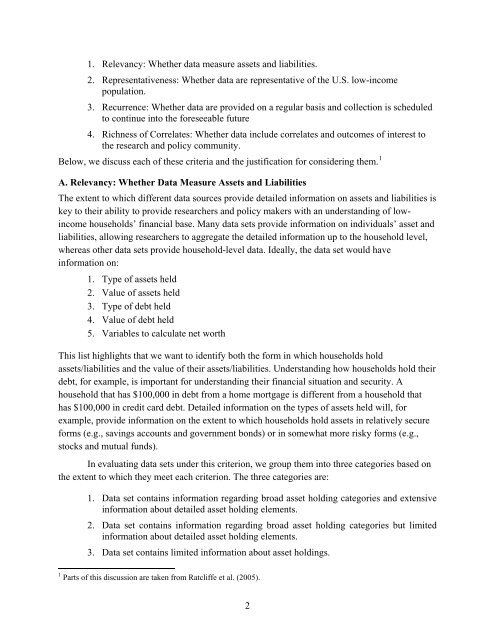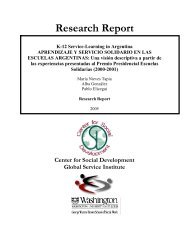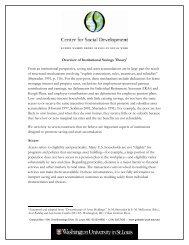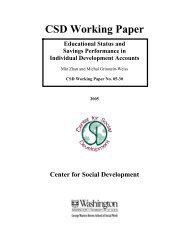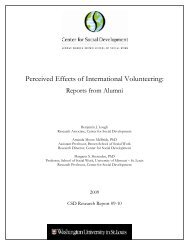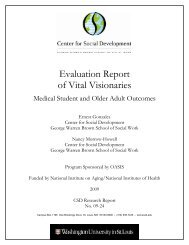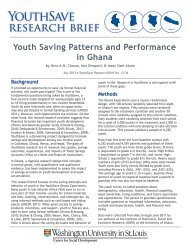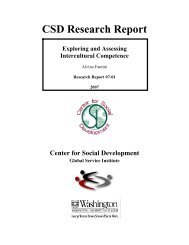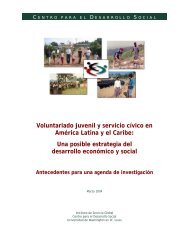Assessing Asset Data on Low-Income Households - Urban Institute
Assessing Asset Data on Low-Income Households - Urban Institute
Assessing Asset Data on Low-Income Households - Urban Institute
Create successful ePaper yourself
Turn your PDF publications into a flip-book with our unique Google optimized e-Paper software.
1. Relevancy: Whether data measure assets and liabilities.<br />
2. Representativeness: Whether data are representative of the U.S. low-income<br />
populati<strong>on</strong>.<br />
3. Recurrence: Whether data are provided <strong>on</strong> a regular basis and collecti<strong>on</strong> is scheduled<br />
to c<strong>on</strong>tinue into the foreseeable future<br />
4. Richness of Correlates: Whether data include correlates and outcomes of interest to<br />
the research and policy community.<br />
Below, we discuss each of these criteria and the justificati<strong>on</strong> for c<strong>on</strong>sidering them. 1<br />
A. Relevancy: Whether <str<strong>on</strong>g>Data</str<strong>on</strong>g> Measure <str<strong>on</strong>g>Asset</str<strong>on</strong>g>s and Liabilities<br />
The extent to which different data sources provide detailed informati<strong>on</strong> <strong>on</strong> assets and liabilities is<br />
key to their ability to provide researchers and policy makers with an understanding of lowincome<br />
households’ financial base. Many data sets provide informati<strong>on</strong> <strong>on</strong> individuals’ asset and<br />
liabilities, allowing researchers to aggregate the detailed informati<strong>on</strong> up to the household level,<br />
whereas other data sets provide household-level data. Ideally, the data set would have<br />
informati<strong>on</strong> <strong>on</strong>:<br />
1. Type of assets held<br />
2. Value of assets held<br />
3. Type of debt held<br />
4. Value of debt held<br />
5. Variables to calculate net worth<br />
This list highlights that we want to identify both the form in which households hold<br />
assets/liabilities and the value of their assets/liabilities. Understanding how households hold their<br />
debt, for example, is important for understanding their financial situati<strong>on</strong> and security. A<br />
household that has $100,000 in debt from a home mortgage is different from a household that<br />
has $100,000 in credit card debt. Detailed informati<strong>on</strong> <strong>on</strong> the types of assets held will, for<br />
example, provide informati<strong>on</strong> <strong>on</strong> the extent to which households hold assets in relatively secure<br />
forms (e.g., savings accounts and government b<strong>on</strong>ds) or in somewhat more risky forms (e.g.,<br />
stocks and mutual funds).<br />
In evaluating data sets under this criteri<strong>on</strong>, we group them into three categories based <strong>on</strong><br />
the extent to which they meet each criteri<strong>on</strong>. The three categories are:<br />
1. <str<strong>on</strong>g>Data</str<strong>on</strong>g> set c<strong>on</strong>tains informati<strong>on</strong> regarding broad asset holding categories and extensive<br />
informati<strong>on</strong> about detailed asset holding elements.<br />
2. <str<strong>on</strong>g>Data</str<strong>on</strong>g> set c<strong>on</strong>tains informati<strong>on</strong> regarding broad asset holding categories but limited<br />
informati<strong>on</strong> about detailed asset holding elements.<br />
3. <str<strong>on</strong>g>Data</str<strong>on</strong>g> set c<strong>on</strong>tains limited informati<strong>on</strong> about asset holdings.<br />
1 Parts of this discussi<strong>on</strong> are taken from Ratcliffe et al. (2005).<br />
2


